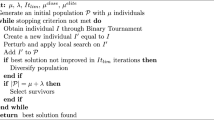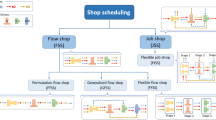Abstract
In this paper, we give an overview of the main results obtained on the complexity of scheduling under the non-idling constraint, i.e, when the jobs assigned to each machine must be processed with no intermediate delay. That constraint is met in practice when the cost of intermediate idle time is too high due to the idle time itself and/or the machine restarting. The non idling constraint is a strong constraint that often needs a new solving approach and most results about classical scheduling problems do not easily extend to the non-idling variant of the problem. In this survey, we mainly consider the non-idling variants of the basic scheduling problems. So, we first present basic properties, complexity results and some algorithms concerning the one-machine non-idling scheduling problem. Then we consider the m-machine non idling scheduling problem. We show that a few basic problems may be solved by rather easy extensions of the algorithm solving their classical counterpart. However, the complexity status of the non idling version of quite easy polynomial basic problems remains an open question. We finally consider a more constrained version of non-idling, called the “homogeneously non idling” constraint, where for any subset of machines, the union of their busy intervals must make an interval and we present the structural property that leads to a polynomial algorithm for unit time jobs and a weak precedence. We conclude by giving some research directions that seem quite interesting to study both for theoretical and practical issues.













Similar content being viewed by others
References
Baker, K. R., Lawler, E. L., Lenstra, J. K., & Rinnoy Kan, A. H. G. (1983). Preemptive scheduling of a single machine to minimize maximum cost subject to release dates and precedence constraints. Operations Research, 31, 381–386.
Baptiste, P. (2005). Scheduling unit tasks to minimize the number of idle periods: A polynomial time algorithm for off-line dynamic power management. In Research Report, Laboratoire d’Informatique CNRS LIX.
Brucker, P. (2004). Scheduling algorithms. Berlin: Springer.
Carlier, J., Moukrim, A., & Guédira, K. (2010). Exact resolution of the ne-machine sequencing problem with no machine idle time. Computers and Industrial Engineering, 59(2), 193–199.
Chrétienne, P. (2008). On single-machine scheduling without intermediate delays. Discrete Applied Mathematics, 13(156), 2543–2550.
Chrétienne, P. (2014). On scheduling with the non-idling constraint. 4OR, 12(2), 101–121.
Coffman, E. G., & Graham, R. L. (1972). Optimal scheduling for two processor systems. Acta Informatica, 1, 200–213.
Garey, M. R., & Johnson, D. S. (1979). Computers and intractability, a guide to the theory of NP-completeness. W. H. Freeman and Co.
Hu, T. C. (1961). Parallel sequencing and assemble line problems. Operations Research, 9, 841–848.
Irani, S., & Pruhs, K. (2005). Algorithmic problems in power management (Vol. 36). New York: ACM Press.
Jouglet, A. (2012). Single-machine scheduling with no idle time and release dates to minimize a regular criterion. Journal of Scheduling, 15(2), 217–238.
Kacem, I., & Kellerer, H. (2014). Approximation algorithms for no idle time scheduling on a single machine with release times and delivery times. Discrete Applied Mathematics, 164(1), 154–160.
Landis, K. (1993). Group technology and cellular manufacturing in the Westvaco Los Angeles VH Department. In Project Report in IOM 581, School of Business, University of Southern California
Lenstra, J. K., & Rinnoy Kan, A. H. G. (1978). Complexity of scheduling under precedence constraints. Operations Research, 26(1), 22–35.
Quilliot, A., & Chrétienne, P. (2013). In G. Kendall, G. Vanden Berghe & B. McCollum (Eds.), Proceedings of the 6th Multidisciplinary International Scheduling Conference, MISTA.
Quilliot, A., & Chrétienne, P. (2013). Homogeneously non-idling schedules of unit-time jobs on identical parallel machine. Discrete Applied Mathematics, 161(10–11), 1586–1597.
Valente, J. M. S., & Alves, R. A. F. S. (2005). An exact approach to early/tardy scheduling with releases dates. Computers and Operations Research, 32, 2905–2917.
Author information
Authors and Affiliations
Corresponding author
Additional information
This is an updated version of the paper that appeared in 4OR, 12(2), 101–121 (2014).
Rights and permissions
About this article
Cite this article
Chrétienne, P. On scheduling with the non-idling constraint. Ann Oper Res 240, 301–319 (2016). https://doi.org/10.1007/s10479-015-2011-5
Published:
Issue Date:
DOI: https://doi.org/10.1007/s10479-015-2011-5




